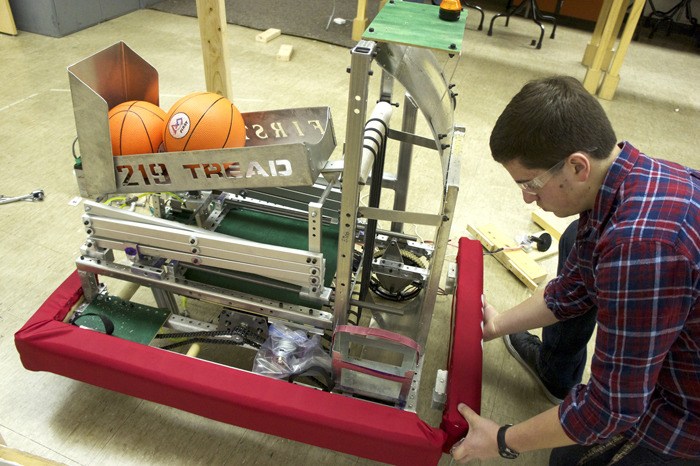Tucked away in a storeroom at Auburn High School sits a robot basketball-dumping machine, tagged and bagged in plastic and ready to roll.
For the past several weeks, the Auburn TREAD 3219 team has frantically labored to assemble the robot, its entry into this weekend’s FIRST Robotics Seattle Olympic and Cascade Regional competition at the CenturyLink Events Center.
TREAD 3219 has participated in the FIRST Robotics program for the past three years, assembling a machine and pitting it against against other schools in a team-based robotics competition.
“This year’s game is called ‘Rebound Rumble,'” said Jacob Torgerson, TREAD 3219 Robotics president. “It’s played on a field separated in the middle by a four-inch bump. You can either cross over the bump or there are three bridges. They are like little see-saws and they’re naturally up, so you have to find a way to get them down.”
On either end of the field are three basketball hoops, arranged at different heights. Two alliances, consisting of three teams per side, try to outscore the opposing alliance by putting basketballs into the hoops – the higher the basket, the higher the score.
Teams also can score points by balancing their robots on the bridges at the end of each round of play.
TREAD 3219’s season began Jan. 7 at the Internet simulcast kickoff, where the team first learned the parameters of this year’s game.
After receiving its building kit on Jan. 9, the team swung into action, working against the clock to design and build the robot before the Feb. 21 deadline.
“We were pretty much behind the whole build season, especially with losing a week to the snow,” said Torgerson, an Auburn senior. “We’re usually behind to begin with because it’s an insane task, but then we lost that week. We pushed this deadline to the very last day.”
According to Torgerson, a member of the team since he was a sophomore, part of the problem was the team’s reliance on progressive designing.
“We’d build something and then realize that ‘oh, this would help us,'” he said. “So we’d get off on a tangent designing and building that. The machining and the manufacturing took the longest.
“There is usually a compromise between programming and machining,” he continued. “You can have a really simple machine, but have intense programming. Or you can have a really easy programming, where you just push one button, but you have a million cogs and things going on. We took the machining compromise.”
The TREAD 3219 machine, which travels on eight-inch wheels, features a scissors lift with a dumper that will elevate to deposit basketballs into the hoops.
“We didn’t want to shoot, because we thought that would be insane programming, and we don’t have that many programmers,” Torgerson said. “It will just pump up, and we have a pneumatic door, because we just want the balls to dump out, that will open.”
Auburn vocational instructor and TREAD 3219 advisor Chris Zawislak said the decision to build a dumper instead of a machine that could shoot the balls in was partially due to the lost week to snow.
“This year we had some hopes and dreams that didn’t come to fruition,” he said. “Initially what they wanted to do was build a shooter so they could launch the balls into the top hoop. We basically decided to go with the dumping system, which is more consistent.”
Despite getting a couple days of testing at a practice field set up at Aviation High School in Des Moines, Torgerson said he’s a little nervous about the robot.
“We tried it but their bump was an inch too high so we just slammed into it,” Torgerson said. “Our bridge-tipper works, though.”
After the robot ships to Seattle, the team will have a little time to work on it and fine tune any problems.
Despite the difficulty in assembling this year’s machine, Torgerson said the experience was invaluable.
“This is what the real world is like,” he said. “Sometimes things go wrong, it’s not all laid out on a silver platter.”
Torgerson and Zawislak also lauded the assistance of the team’s mentors, including Boeing employee Paul Bowman and PDO Precision machinist Jeff Olberg.
“They came in and talked about engineering and helped them with the process and problems,” Zawislak said. “(This program) is immensely valuable for these kids. The mentor support we have is incredible. It’s all real world. Even though the problem is kind of fictional, the process is real world. You come across a problem, you have to research how to fix it.
“This program gives them the most real world application for what they’re learning in school.”


